Lately I’ve been having a lot of conversations around investment terms with searchers, as well as investors.
About 15 years ago, I interned at a search fund. And, over the last few years, I’ve started to invest in the asset class going direct as well as through funds of search funds.
Investing in search funds is a great way to scratch my entrepreneurial itch, extremely rewarding when a searcher finds success, and can be economically rewarding too.
This post is my attempt to share thoughts on self funded search economics in an effort to contribute to the search fund community, get feedback on my thinking from a wider audience, and of course meet more people who are doing searches/investing and may want to collaborate (please feel free to reach out!).
You can watch a video of me explaining this model here, and download the excel here:

Enterprise Value
The standard finance equation is enterprise value = debt + stock – cash. Enterprise value is how much the company itself is worth. Many times people confuse it with how much the stock is worth and find the “minus cash” part of this really confusing.
So, you can rearrange this equation to make it stock = enterprise value – debt + cash. Make more sense now?
Enterprise value is just how much you’re willing to pay for the company (future cash flows, intellectual property, etc), not the balance sheet (debt and cash).
Most investors and searchers think about the EBITDA multiple of a company on an enterprise value basis because they’ll be buying it on a cash free, debt free basis. It becomes second nature to think about EBITDA multiples and know where a given business should fall given scale, industry, etc.
However, I believe this second nature way of thinking of things can be a massive disadvantage to investors given the way EV and multiples are talked about in our community currently.
Sources of capital, the typical way to calculate enterprise value for self funded searchers
If you’ve ever looked at or put together a teaser for a self funded search deal, you will notice that the deal value is equal to the sum of the sources of capital minus deal fees and cash to the balance sheet.
As a simple example, if there is $4 mm of debt to fund the deal, $1 mm of equity, and $200k of deal fees, the enterprise value = $4 mm + $1 mm – 200k = $4.8 mm.
We’ll use slightly more complex numbers in our example: If a searcher is taking a $3.2 mm SBA loan, $850k seller note, putting in $120k themselves, getting $350k of equity from the seller, a $500k earnout, and $1.2 mm of equity financing minus $350k to the balance sheet and $250k of deal fees, then the enterprise value will be $5.62 mm.
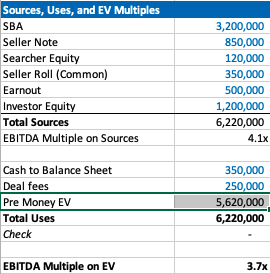
Our example company has $1.5 mm of EBITDA, so the EBITDA multiple is 3.7x. This is a pretty attractive acquisition multiple for a business that meets traditional search criteria (recurring revenues, fragmented competition, high gross margins, low customer concentration, etc).
If you’re seeing a search fund deal for the first time, the headline of “we’re buying a decent company for 3.7x, and replacing a tired owner with a hungry operator” is pretty exciting!
However, if you’re an investor, there is some nuance to this enterprise value number and the true EBITDA multiple you are investing in.
The trick with self funded enterprise value
The security that most self funded search investors get in a deal is participating preferred stock with a paid in kind dividend. This means when there’s an exit, you get your money back before any other equity holder, then get a certain percent of the business, and whatever dividend you’ve been owed in the interim accrues to your principle.
It’s a really favorable security for the investor, and one that is basically impossible to get in VC where straight preferred stock is much more common (no pun intended).
The key terms are what percent of common equity does this security convert into after the originally principal is paid back, and what is the dividend.
The share of common equity the investor group will get typically ranges from 10-50% of the total common stock. The dividend rate is usually 3-15%. The average I’m seeing now is around 30% and 10% for common and dividends respectively.
The strange this about the enterprise value quoted to investors in a teaser/CIM is that it doesn’t change as the percent of common changes, even though this has large implications for how much the common equity is worth and the value investors receive.
For example, I may get a teaser where the sources of investment – cash to balance sheet – deal fees = $3.7 mm for a $1 mm EBITDA company, which would imply a 3.7X EBITDA multiple. Let’s say the searcher is offering investors 30% of the common and a 10% dividend.
Let’s now say that the searcher is having a tough time raising capital and changes their terms to 35% of common and a 12% dividend. Does the effective enterprise value change for investors? I would argue yes, but I would be surprised to see it changed in the CIM/teaser.
This isn’t a knock on searchers or the search fund community. It’s just kind of how things are done, and I think this is mostly because it’s really hard to think about how the enterprise value has changed in this scenario.
However, the natural way of using EBITDA multiples to think about value for a business that is so common in PE/SMB can be extremely misleading for investors here. You may be thinking 3.7X for this type of business is a great deal! But, what if the security you’re buying gets 5% of the common?
If you’re in our world, you may counter this point by saying most searchers will also supply a projected IRR for investors in their CIM. However, IRR is extremely sensitive to growth rate, margin expansion, and terminal value. While the attractiveness of the security will be reflected, it can be greatly overshadowed by lofty expectations.
To get more clarity and have a slightly different mental model on the effective price investors are paying for this business, let’s go back to basics. Enterprise value should be debt + preferred stock + common stock – cash.
We know the values of each of these numbers, except the common. So, the main question here becomes: how much is the common equity worth?
Calculating value of common equity for self funded search funds
Equity value for most search fund deals = preferred equity from investors + the common equity set aside for the searcher and sometimes also advisors, board, seller.
We know that the preferred equity is investing a certain amount for a certain amount of common equity. The rub is that they are also getting a preference that they can take out before any common equity gets proceeds, and they are getting a dividend.
So, the exercise of valuing the common equity comes down to valuing the preference and dividend.
In my mind, there are three approaches:
- The discount rate method where you take the cash flows you’ll get in the future from the pref/dividends and discount them back at the discount rate of your choice. I am using 30% in my model which I believe accurately compensates investors for the risks they are taking in a small, highly leveraged investment run by an unproven operator. If you believe in efficient markets, this number also fits as it mirrors the historical equity returns as reported by the Stanford report, with a slight discount given this asset class has clearly generated excess returns relative to other assets on a risk adjusted basis, hence interest in these opportunities from an expanding universe of investors.
- The second method is to calculate how much money you’d get from your preference and dividends, taking into account that per the Stanford study around 75% of search funds will be able to pay these sums, and then discount these cash flows back at a rate more in line with public equities (7% in my model). This yields a much higher value to the preference/dividend combo, and therefore lowers the implied value of the common equity.
- The last method is to just say nope, there is no value to the preference and dividend. I need them and require them as an investor, but they are a deal breaker for me if they aren’t there, and therefore they don’t exist in my math. This of course makes no logical sense (you need them, but they also have no value?), but I’ve left it in as I think many investors probably actually think this way and it creates a nice upper bound on the enterprise value. Side note, as with obstinate sellers, jerk investors are usually best avoided.
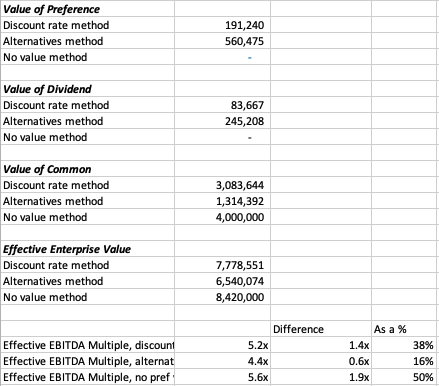
In our example, you can see a breakdown of the preference value, dividend value, and therefore common value and enterprise value for this deal.
In each case, the effective EBITDA multiple moves from 3.7x to something much higher (see the last 3 lines).
There are some simplifying assumptions in the model (no accruing dividend, all paid in last year), and some weird stuff that can happen (if you make the hold time long and the dividend greater than the 7% equity discount rate, the value of the dividend can get really big).
These flaws aside, I think this creates a nice framework to think through what the common is actually worth at close, and therefore what enterprise value investors will be paying in actuality.
It’s worth noting that the whole point of this is to benchmark the value you’re getting relative to market transactions in order to understand where you want to deploy your capital.
This creates a method to translate cash flow or EBITDA multiples of other opportunities on an apples to apples basis (if only there were a magical way to translate the risk associated with each as well!).
Another note, we could calculate the value of the common to be what this asset would trade at market today in a well run auction process minus any obligations (debt, preference, seller financing). However, I think that understates the option value inherent in this equity, a value that is only realized when a new manager takes over with more energy and know how.
There is a finance nerd rational for this. If you plot the value of equity in a leveraged company on a chart, it mirrors the payout of a call option. In both cases, the value of the security increases at a certain inflection point: when the value of equity rises above the strike price in an option, and when the enterprise value of a company rises above the debt level in a levered company.
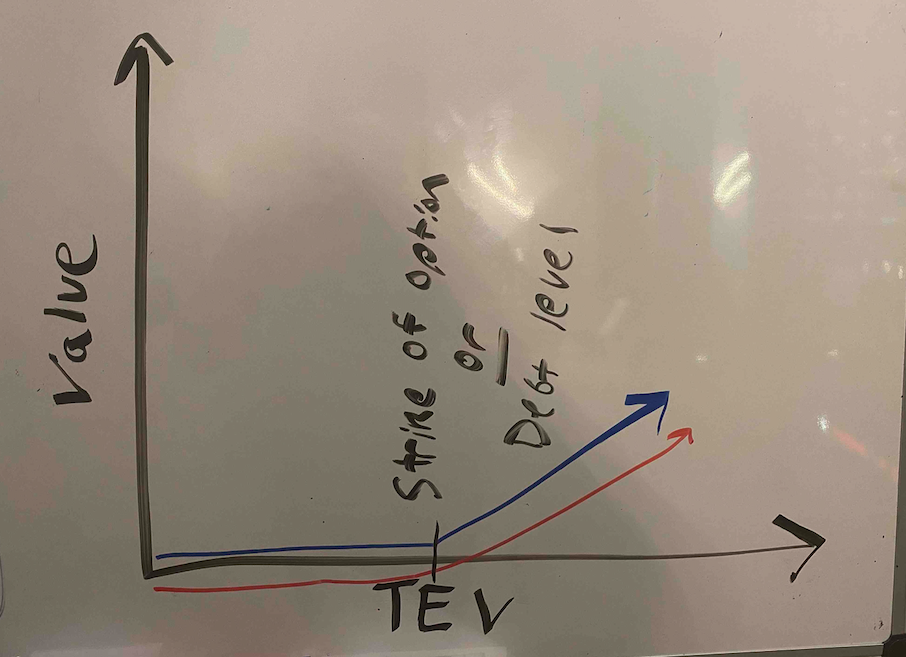
The common equity of a highly levered company can therefore be valued by a similar methodology as the call option: Black Scholes. If you remember back to finance class, increasing volatility will increase the value of an option.
In the search fund case, we’ve (hopefully) increased the (upside) volatility and therefore create more value than simply selling the company today.
A few more thoughts on investor economics
There are a few other ways to think about the economics you get as an investor to best understand if this is the deal for you.
First, you may want to think about how much your investment will be worth day 1. The key lever in this model is what discount this company is being bought for relative to fair market value. For example, the searcher may have proprietary sourced a great company and is buying it for 25% below what it would trade at in a brokered auction.
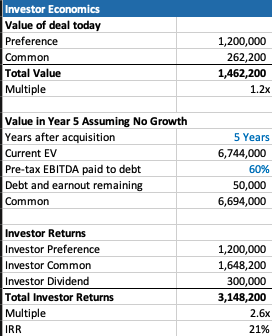
This is very much a “margin of safety” philosophy on things. Same with the calculation on how much you’ll receive in year 5 (after QSBS hits) assuming no growth in the business.
The only problem with each of these calculations is that they never play out in practice. Most companies don’t just stay the same, you’re either in a rising tide or you’re in trouble. And, you’re almost never going to sell in year 1, and definitely not for a slight premium to what it was bought for.
However, if your investment is worth 30% higher day one, and you can make a 20% IRR assuming nothing too crazy happens either way in the business, that’s not a bad place to start. Add in a strong searcher, decent market, some luck, and you’re off to the races.
Thoughts on searcher economics
A lot of this post has considered things from the investor perspective as my main quandary was related to how to create an EBITDA multiple that made sense for investors.
However, the point of this post is not to say searchers are misrepresenting or being unrealistic with their terms. In fact, I think it’s quite logical that self funded searchers capture the massive economic value that they do.
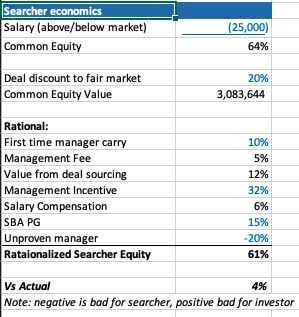
There are many reasons why self funded searchers deserve the lion share of the common equity.
First, they are providing a nice service of giving investors a positive expected value home to park their money with much lower correlation to the market than other asset classes ($1 mm EBITDA companies don’t see lots of multiple contraction/expansion throughout cycles).
Most money managers that fit that criteria are taking a 2/20, of course they also usually have a track record. So, I’ve used a 10% carry in my model, but stuck to 2% annual management fee.
The searcher spent a lot of time, and probably money, finding this company. That’s a lot of value, especially if it’s a below market price. They should be able to capture a lot of the value in finding a below market deal.
The searcher may be taking a below market salary, and needs to get comped like any CEO, with stock options. In my example model I have $1 mm of stock vesting over the hold period, as well as extra comp for taking a below market salary.
Searchers are also usually putting their financial standing at risk by taking a personal guarantee on the bank/SBA loan. This is really tough to put a number on, as is the last line in my framework where searchers are dinged for lack of experience. Like any good model, you need a few lines that you can fudge to make the math work 🙂
What you do think?
I’m shocked that I wrote all this. I was going to type a few paragraphs and a quick excel. However, putting this to paper has been a great exercise for me to sharpen my thinking.
Now I’d like you to help me further. Where do you think this should be changed in this framework? How do you think about things from the investor and/or searcher side?
Feel free to shoot me a note if you have thoughts (even just to tell me I’m being way too academic with this, which I actually agree with).
Lastly, a post like this is really a trap I’m putting on the internet to catch any like minded people in so that we can figure out ways to collaborate now or in the future. So, at the very least, connect with me on LinkedIn 🙂

Excellent blog here! Also your website loads up very fast!
What host are you using? Can I get your affiliate link to your host?
I wish my web site loaded up as fast as yours lol
Usually I don’t learn post on blogs, but I would like to say that this write-up very forced me to check out and do
so! Your writing taste has been amazed me. Thanks, quite great
post.
I don’t even know how I ended up here, but I thought this post was great.
I do not know who you are but certainly you’re going to a famous blogger if
you aren’t already 😉 Cheers!
Hi there to all, because I am truly keen of reading this website’s post
to be updated regularly. It carries good data.
Thank you for the auspicious writeup. It in fact was a
amusement account it. Look advanced to more added agreeable from
you! By the way, how could we communicate?
Hey there, You’ve done a fantastic job. I will definitely digg it
and personally recommend to my friends. I’m sure they’ll
be benefited from this website.
Hello! I know this is kind of off topic but I was wondering which blog
platform are you using for this site? I’m getting sick and tired of WordPress because I’ve had
problems with hackers and I’m looking at alternatives for another platform.
I would be awesome if you could point me in the direction of a good platform.
Have you ever considered about adding a little bit more than just your articles?
I mean, what you say is important and all.
However just imagine if you added some great pictures or
video clips to give your posts more, “pop”! Your content is excellent but with images and videos, this blog could
certainly be one of the greatest in its niche.
Amazing blog!
Hey there! I simply wish to give you a big thumbs up for the great information you have got here on this post.
I am returning to your blog for more soon.
I think everything typed was very reasonable. But, what about this?
what if you composed a catchier title? I ain’t saying your content is not solid.,
but what if you added something to maybe get folk’s attention? I mean Thoughts on Search Fund Economics – Phil Strazzulla's Blog is a little plain. You should peek at Yahoo’s home page and note how they write news headlines to get people interested.
You might try adding a video or a pic or two to grab people interested about what you’ve written. In my opinion, it would make your posts a little
bit more interesting.
I blog quite often and I genuinely appreciate your information. The article has truly peaked my
interest. I am going to bookmark your blog and
keep checking for new details about once a week.
I subscribed to your Feed too.
Hi! This is kind of off topic but I need some advice from an established blog.
Is it very difficult to set up your own blog?
I’m not very techincal but I can figure things out pretty quick.
I’m thinking about setting up my own but I’m
not sure where to start. Do you have any tips or suggestions?
Appreciate it
Wow, this article is fastidious, my sister
is analyzing these things, so I am going to convey her.
Keep this going please, great job!
Oh my goodness! Amazing article dude! Many thanks, However I am having troubles with your RSS.
I don’t know the reason why I am unable to subscribe to it.
Is there anyone else having similar RSS problems? Anyone who knows the solution can you kindly respond?
Thanx!!
Can I just say what a relief to discover someone that actually knows what they are talking about over
the internet. You actually realize how to bring a problem
to light and make it important. More people must check this out and understand this side of the story.
I was surprised that you’re not more popular since you
certainly have the gift.
I just like the valuable info you provide for your articles.
I’ll bookmark your weblog and test once more right here frequently.
I am slightly certain I’ll learn plenty of new stuff right right here!
Best of luck for the next!
Pretty! This has been an extremely wonderful article.
Thank you for supplying this info.
Hi! This is kind of off topic but I need some help
from an established blog. Is it very hard to set up your own blog?
I’m not very techincal but I can figure things out pretty fast.
I’m thinking about making my own but I’m not sure where
to begin. Do you have any tips or suggestions?
Cheers
I’m not sure exactly why but this blog is loading extremely slow
for me. Is anyone else having this issue or is it a
problem on my end? I’ll check back later on and see if the problem still exists.
Excellent beat ! I would like to apprentice while you amend your website, how could i subscribe for a blog site?
The account aided me a acceptable deal. I had been a
little bit acquainted of this your broadcast provided bright clear idea
I could not resist commenting. Perfectly written!
Hi to every body, it’s my first go to see of this weblog; this webpage contains remarkable and really excellent data in support of readers.
You’re so cool! I do not suppose I’ve read through anything like this before.
So nice to discover somebody with original thoughts
on this issue. Seriously.. many thanks for starting this up.
This web site is something that is required on the web,
someone with a bit of originality!
certainly like your web site however you need to test the spelling
on several of your posts. A number of them are rife with spelling problems and I to find it very bothersome to inform the reality then again I’ll surely come
back again.
It’s a pity you don’t have a donate button! I’d certainly donate to this fantastic
blog! I suppose for now i’ll settle for bookmarking and adding your RSS feed to my Google account.
I look forward to brand new updates and will talk about this
blog with my Facebook group. Talk soon!
Great items from you, man. I have consider your stuff previous to and you are
just extremely great. I actually like what you have got
right here, really like what you are stating and the way by which you assert it.
You are making it enjoyable and you continue to take care of to stay it smart.
I can not wait to read far more from you.
This is actually a terrific site.
What’s up, its nice article on the topic of media print, we all be aware of media is a
wonderful source of facts.
Every weekend i used to visit this site, for the reason that i wish for enjoyment,
since this this web site conations in fact fastidious funny stuff too.
Hello there, just became alert to your blog through Google, and found that it’s really
informative. I’m going to watch out for brussels. I’ll be grateful
if you continue this in future. Lots of people will be benefited from your
writing. Cheers!
Hello there! Do you know if they make any plugins to help with SEO?
I’m trying to get my blog to rank for some
targeted keywords but I’m not seeing very good gains.
If you know of any please share. Appreciate it!
If some one desires expert view about blogging and site-building after that i
advise him/her to go to see this website, Keep up the fastidious job.
Hey I know this is off topic but I was wondering if you knew of any widgets I could add to my blog that automatically tweet my newest
twitter updates. I’ve been looking for a plug-in like
this for quite some time and was hoping maybe you would have some experience with something like this.
Please let me know if you run into anything. I truly enjoy reading your
blog and I look forward to your new updates.
I like the helpful information you provide in your articles.
I will bookmark your blog and check again here frequently.
I’m quite sure I will learn lots of new stuff right here!
Best of luck for the next!
I got this web page from my buddy who shared with me about
this web site and at the moment this time I am visiting
this web site and reading very informative posts at this time.
Wonderful work! This is the kind of information that should be shared across the web.
Disgrace on the seek engines for no longer positioning this put up higher!
Come on over and discuss with my site . Thank you =)
An outstanding share! I have just forwarded this
onto a colleague who has been conducting a little research
on this. And he in fact ordered me lunch because I stumbled upon it for him…
lol. So let me reword this…. Thanks for the meal!! But yeah, thanx for spending the time to talk about this subject here on your
internet site.
I blog often and I truly appreciate your content.
The article has really peaked my interest.
I’m going to bookmark your blog and keep checking for new details about once per week.
I opted in for your Feed as well.
There is certainly a lot to know about this topic.
I like all of the points you made.
When I initially commented I clicked the “Notify me when new comments are added” checkbox and now each time a comment is added I get four
emails with the same comment. Is there any way you can remove people from that service?
Appreciate it!
I just like the valuable information you supply to
your articles. I’ll bookmark your blog and test once more here
frequently. I am slightly sure I will learn many new stuff proper right here!
Best of luck for the following!
Its like you read my mind! You appear to know a lot about this, like you wrote the book
in it or something. I think that you can do with some pics to drive the message
home a bit, but instead of that, this is fantastic blog.
An excellent read. I will certainly be back.
Asking questions are actually pleasant thing if you are not understanding anything completely, except this piece of writing gives fastidious understanding
yet.
Hi, Neat post. There’s a problem with your web site in internet explorer, could check this?
IE nonetheless is the market leader and a big portion of other people will pass over your wonderful writing due to
this problem.
Hi there mates, nice paragraph and fastidious
urging commented at this place, I am in fact enjoying by these.
Good day! I know this is somewhat off topic but I was wondering which blog platform are you using for this site?
I’m getting fed up of WordPress because I’ve had issues with hackers and I’m looking at options for another
platform. I would be awesome if you could point me in the direction of a good platform.
You are so awesome! I do not suppose I’ve truly read through something like
that before. So nice to find another person with some genuine thoughts
on this topic. Seriously.. thank you for starting this up.
This site is something that is required on the web, someone with some
originality!
It’s hard to find knowledgeable people in this particular subject, but you sound like
you know what you’re talking about! Thanks
Hello to all, how is everything, I think every one is getting more
from this website, and your views are fastidious
in support of new people.
I am sure this article has touched all the internet visitors, its really really pleasant piece of writing on building up new website.